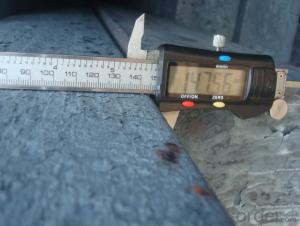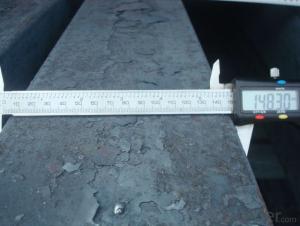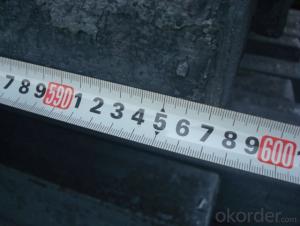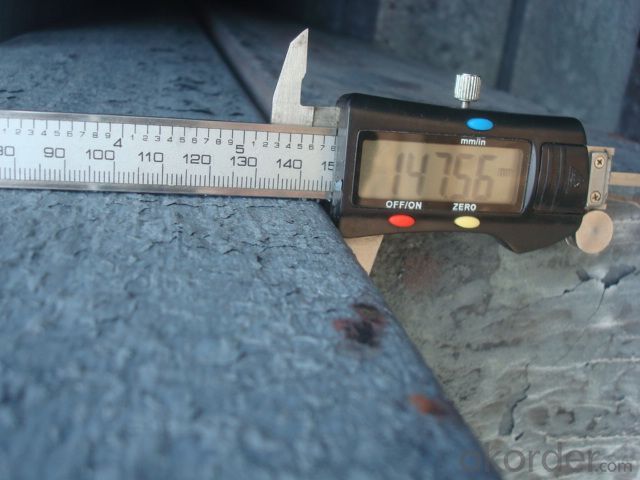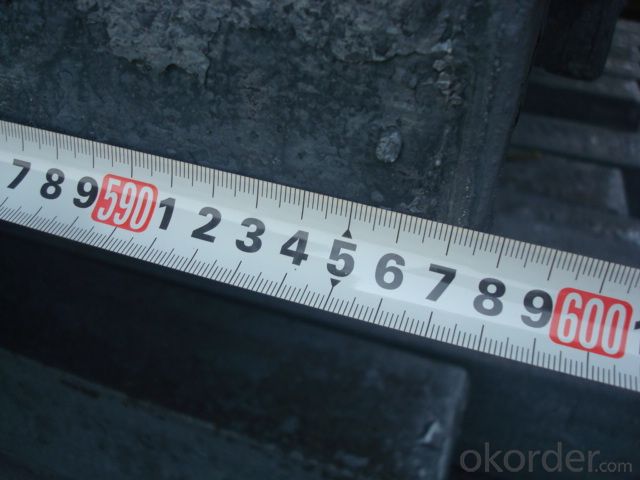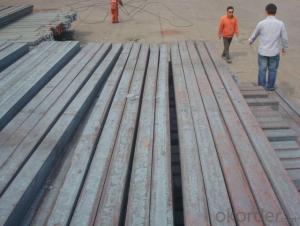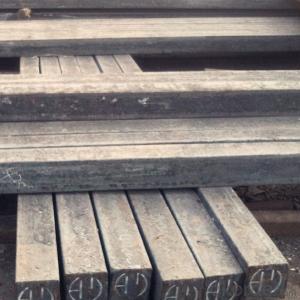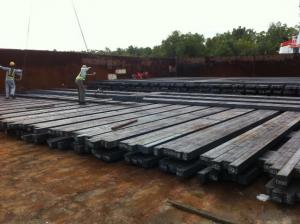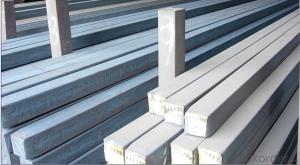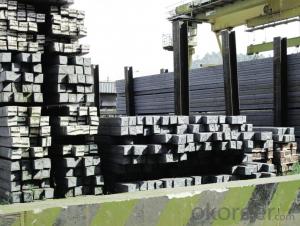Square Steel Billets 70mm 100mm 130mm 150mm 3SP
- Loading Port:
- Tianjin
- Payment Terms:
- TT OR LC
- Min Order Qty:
- 1000 m.t.
- Supply Capability:
- 30000 m.t./month
OKorder Service Pledge
OKorder Financial Service
You Might Also Like
STEEL BILLET
1.Brief description
Steel billet(ingot) by cogging or breakdown of semi-finished products, is the raw material of all kinds of steel mill. Billet section of square, round, flat, rectangular and abnormity of several kinds of, mainly related to the shape of rolled products.
2.Features
Rectangular billet continuous casting billet and mainly general carbon steel, low carbon low silicon cold-rolled material, high quality carbon structural steel, high strength low alloy steel, special steel, etc.
The billet is mainly divided into two kinds from the shape:
Slab: cross section width and height of the ratio of the larger, mainly used for rolling plate.
Billet: equal cross section width and height, or a huge difference, mainly used for rolling steel, wire rod. ,
Steel billets have distinct characteristics as compared with already furnished steel bars and products. Billets have a specific grain structure, which enables the metal to be processed more intricately. Steel billets are also known for their malleability and ductility, especially when exposed to varying temperatures during shaping and molding.
3.Processing
Steel billets are considered fresh and raw, and they must undergo a series of manufacturing processes before they can be used for various purposes. Billets are made by means of freezing molten liquid, and are later exposed to extremely low temperatures in order to allow the metal to take shape and solidify in chemical structure. The temperature manipulates the metal's physical properties, and tones its strength and durability. The subsequent processes provide the metal's curved mold design so that it can fit the allotted space provided by other machines, which complete the finishing procedures.
4.Pictures
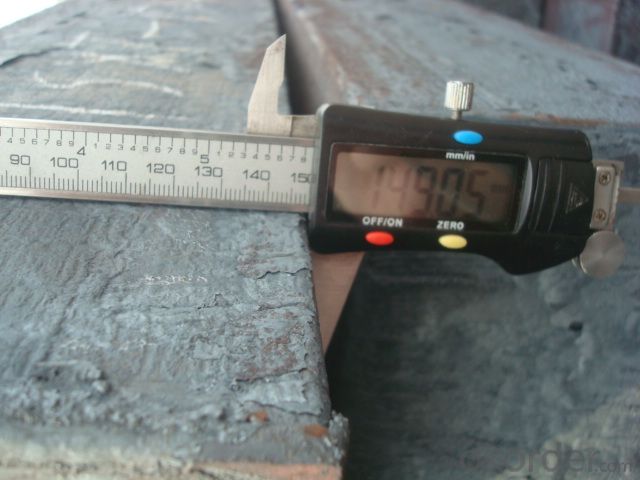
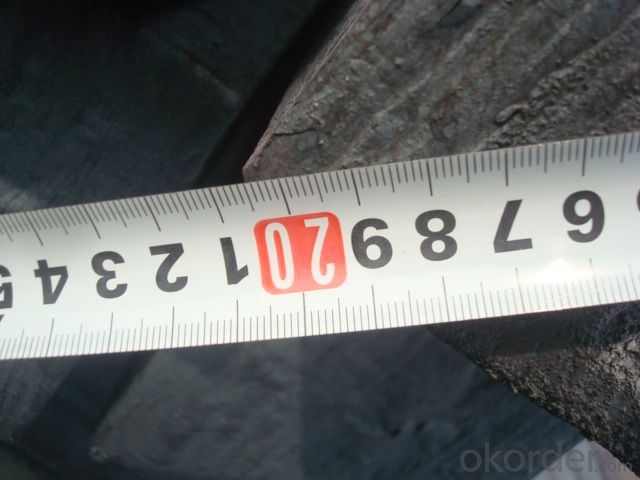
5.Usage
Billets, or ingots (as they sometimes referred to), are not of practical use until they have been formed into more functional shapes and sizes. While they have already been put in the furnace, they still require a series of shaping and molding procedures such as hot and cold working, milling and cutting before they are sold in hardware stores, or used for different applications. The unformed billets, however, can be used in striking currency such as coins and as reserves, similar to gold bars.
6.Detailed specification
Hot rolled billet steel
Size: 50x50mm-180x180mm
Steel Grade: 3SP, 5SP,Q195,Q235,Q255,Q275 Length:3m-12m
MOQ: 1000MT/size
Payment term: TT or LC
Packing: in bulk , bundle
Shipment: by container , bulk vessel
Packaging Details: bundles with steel strips or as customers's requirements
Delivery time: 15-30 days after the deposit
Loading port:Tianjin, or other port China
Origin : China
Inspection:Third party inspection before loading.
- Q: How do steel billets contribute to the overall cost-effectiveness of a structure?
- Steel billets contribute to the overall cost-effectiveness of a structure due to their versatility and efficiency in construction. These pre-formed, semi-finished steel products can be easily shaped and transformed into various components, reducing the need for extensive machining and fabrication processes. Their strength and durability ensure long-term stability and low maintenance costs, while their high recyclability promotes sustainability and reduces material waste. Additionally, the standardized sizes and consistent quality of steel billets facilitate efficient production and shorter construction timelines, ultimately leading to cost savings for building projects.
- Q: How do steel billets contribute to the manufacturing of marine gear?
- The unique characteristics and properties of steel billets are crucial in the manufacturing of marine gear. Marine gear, which includes propeller shafts, gears, and bearings, requires high strength, resistance to corrosion and wear. To start the manufacturing process, steel billets are used as the starting material. These semi-finished metal forms are typically made from carbon or alloy steel and are shaped into long, rectangular bars. The specific marine gear components are created through further processing of these billets. The strength of steel billets is ideal for marine gear manufacturing as it allows them to withstand heavy loads and intense pressures in marine environments. This ensures the durability and reliability of the gear components, minimizing failures and enhancing safety. Corrosion resistance is also crucial in marine gear manufacturing. Steel billets can be made from stainless steel, which contains chromium and other alloying elements that form a protective layer on the surface. This protective layer prevents rust and corrosion caused by exposure to saltwater, ensuring the longevity and performance of the components in harsh marine conditions. Additionally, steel billets can be heat-treated to improve their mechanical properties such as hardness, toughness, and wear resistance. This involves heating the billets to specific temperatures and then cooling them rapidly or slowly, depending on the desired properties. Heat-treated steel billets provide the necessary hardness and wear resistance required for gears, shafts, and bearings to withstand the constant friction and stress in marine applications. In conclusion, steel billets play a significant role in marine gear manufacturing by providing the required strength, corrosion resistance, and mechanical properties. They serve as the foundation material for creating durable and reliable components that can withstand the challenging conditions of the marine environment.
- Q: How are steel billets used in the production of oil and gas pipelines?
- Steel billets are a crucial component in the production of oil and gas pipelines. They serve as the starting material for the manufacturing process of these pipelines. Steel billets are essentially semi-finished steel products that are often in a rectangular or square shape. To produce oil and gas pipelines, the steel billets undergo a series of manufacturing processes. First, the billets are heated to high temperatures in a furnace. This process, known as billet heating, allows the steel to become more malleable and easier to shape. Once the billets reach the desired temperature, they are then passed through a series of rollers to transform their shape into a cylindrical form. This process is called hot rolling, and it helps to further enhance the mechanical properties of the steel, making it stronger and more durable. After hot rolling, the steel is typically subjected to a process called quenching and tempering. Quenching involves rapidly cooling the steel to increase its hardness, while tempering is a heat treatment process that reduces the brittleness of the steel, making it less prone to cracking. Once the steel billets have been transformed into cylindrical pipes through these processes, they are then welded together to form the final pipeline. Welding ensures the integrity and strength of the pipeline, allowing it to withstand the high pressures and harsh environments associated with the transportation of oil and gas. Overall, steel billets play a vital role in the production of oil and gas pipelines. They serve as the foundation material, undergoing various manufacturing processes to transform them into durable, high-strength pipes that can efficiently transport oil and gas across vast distances.
- Q: What are the different types of steel billet defects?
- There are several different types of steel billet defects that can occur during the manufacturing process. These defects can have an impact on the quality and performance of the final product. Some common types of steel billet defects include: 1. Surface defects: These are flaws or irregularities that occur on the outer surface of the billet. Examples include cracks, scale, and scratches. Surface defects can weaken the billet and reduce its overall strength. 2. Internal defects: These defects occur within the billet and are not visible on the surface. They can be caused by factors such as non-metallic inclusions, voids, or gas pockets. Internal defects can compromise the structural integrity of the billet and lead to failures or deformations. 3. Segregation: This defect refers to the uneven distribution of alloying elements within the billet. It can result in inconsistent mechanical properties across the billet, leading to variations in strength or hardness. 4. Pipe: Pipe defects occur in the center of the billet and are caused by the formation of a cavity during solidification. This defect can weaken the billet, making it more susceptible to cracking or other forms of failure. 5. Incomplete solidification: This defect occurs when the billet does not fully solidify during the casting process. It can lead to internal cracks or voids, reducing the overall quality and strength of the billet. 6. Surface decarburization: This defect occurs when the surface of the billet loses carbon during the heating or cooling process. It can result in reduced hardness and wear resistance in the final product. It is important for manufacturers to closely monitor and control the production process to minimize the occurrence of these defects. Various techniques such as quality control checks, heat treatment, and proper handling can help prevent or mitigate the impact of these defects on the final product.
- Q: What are the different international standards for steel billets?
- There are several international standards for steel billets, including the American Society for Testing and Materials (ASTM) standards, the International Organization for Standardization (ISO) standards, and the European Committee for Standardization (EN) standards. These standards define the chemical composition, mechanical properties, and dimensions of steel billets, ensuring their quality and compatibility for various industries and applications worldwide.
- Q: What are the different joining methods used for steel billets?
- There are several different joining methods used for steel billets, depending on the specific application and desired outcome. Some of the most common joining methods include welding, brazing, and adhesive bonding. Welding is a widely used joining method for steel billets. It involves melting the edges of the billets and fusing them together, either with or without the use of a filler material. Welding can be done through various processes such as arc welding, resistance welding, or gas welding. It offers strong and durable joints, but the process can be complex and may require skilled operators. Brazing is another joining method used for steel billets. It involves heating the billets and melting a filler metal with a lower melting point, which is then allowed to flow between the joint surfaces and solidify. Brazing offers good strength and is often used for joining billets that are not easily weldable due to their composition or thickness. Adhesive bonding is a non-mechanical joining method that uses adhesives to bond the steel billets together. Adhesive bonding offers several advantages, including lightweight joints, uniform distribution of stress, and the ability to join dissimilar materials. It is also a versatile method that can accommodate various shapes and sizes of billets. However, adhesive bonding may not provide the same level of strength as welding or brazing, and it can be sensitive to environmental factors such as temperature and humidity. Other joining methods used for steel billets include mechanical fastening, such as bolting or riveting, and thermal joining methods like diffusion bonding or friction welding. Each joining method has its own advantages and limitations, and the choice of method depends on factors such as the specific application requirements, material properties, and cost considerations.
- Q: What are the common testing methods used for quality control of steel billets?
- There are several common testing methods used for quality control of steel billets. These methods ensure that the billets meet the required specifications and are suitable for further processing. 1. Visual Inspection: This is the initial step in quality control, where the billets are visually inspected for any surface defects such as cracks, seams, or discontinuities. 2. Dimensional Inspection: Billets are measured using various instruments to ensure they meet the specified length, width, and thickness requirements. 3. Ultrasonic Testing (UT): This non-destructive testing method uses high-frequency sound waves to detect internal defects in the billets. UT can identify defects such as inclusions, voids, or cracks that are not visible to the naked eye. 4. Magnetic Particle Inspection (MPI): This method involves magnetizing the billets and applying iron particles to detect surface and near-surface defects. Any defects will cause the particles to gather, indicating the presence of a defect. 5. Dye Penetrant Inspection (DPI): It involves applying a liquid dye to the surface of the billets, which seeps into any surface cracks or defects. After a certain time, excess dye is removed, and a developer is applied to make the defects visible. 6. Hardness Testing: This method measures the hardness of the billets using various techniques like Rockwell, Brinell, or Vickers hardness testing. It helps determine the billet's strength and resistance to deformation. 7. Chemical Analysis: Chemical composition analysis is conducted to ensure that the steel billets meet the required chemical specifications. This is done using spectroscopic techniques like Optical Emission Spectroscopy or X-Ray Fluorescence. 8. Microstructure Examination: A microscopic examination is performed to study the microstructure of the steel billets. It helps determine the grain size, presence of inclusions, and overall quality of the steel. By employing these testing methods, manufacturers can ensure the quality and reliability of steel billets, which in turn guarantees the safety and performance of the final steel products.
- Q: What are the main factors affecting the hardness of steel billets?
- The main factors affecting the hardness of steel billets are the carbon content, the alloying elements present in the steel, the cooling rate during the quenching process, and the heat treatment process employed.
- Q: What are the different types of steel billet rolling techniques?
- There are several different types of steel billet rolling techniques used in the manufacturing process. These techniques are employed to shape the steel into desired forms and dimensions. Some of the commonly used techniques include: 1. Hot rolling: This is the most widely used technique where the steel billet is heated to high temperatures and then passed through a series of rolling mills. The hot rolling process helps in reducing the thickness and increasing the length of the steel billet. 2. Cold rolling: In this technique, the steel billet is rolled at room temperature. It is used to produce steel with a smooth surface finish and precise dimensions. Cold rolling is often used for producing steel sheets, strips, and bars. 3. Ring rolling: This technique is used to produce seamless rings of steel. The steel billet is heated and then rolled between two rotating rolls, which gradually shape the billet into a ring. Ring rolling is commonly used in the production of bearings, gears, and flanges. 4. Continuous casting and rolling: This technique involves the continuous casting of molten steel into billets, which are then directly rolled into desired shapes. Continuous casting and rolling eliminate the need for separate casting and rolling processes, making it a more efficient and cost-effective technique. 5. Cross-rolling: Cross-rolling is used to produce steel billets with non-uniform cross-sections. The billet is rolled between two rolls that have different profiles, resulting in a billet with a desired shape. 6. Skew rolling: Skew rolling is a technique used to produce steel balls used in various industries, such as mining and cement production. The steel billet is rolled between two rotating rolls at an angle, which creates a helical motion and forms the ball shape. These are just a few examples of the different types of steel billet rolling techniques. Each technique has its own advantages and is used based on the desired final product and manufacturing requirements.
- Q: What are the main factors affecting the thermal expansion of steel billets?
- The main factors affecting the thermal expansion of steel billets include temperature, composition of the steel, and the grain structure of the material.
Send your message to us
Square Steel Billets 70mm 100mm 130mm 150mm 3SP
- Loading Port:
- Tianjin
- Payment Terms:
- TT OR LC
- Min Order Qty:
- 1000 m.t.
- Supply Capability:
- 30000 m.t./month
OKorder Service Pledge
OKorder Financial Service
Similar products
Hot products
Hot Searches
Related keywords
